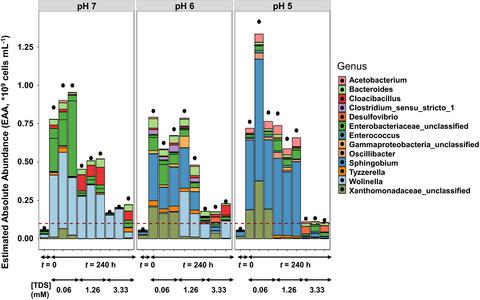当前位置:
X-MOL 学术
›
Microb. Biotechnol.
›
论文详情
Our official English website, www.x-mol.net, welcomes your
feedback! (Note: you will need to create a separate account there.)
Homoacetogenesis and microbial community composition are shaped by pH and total sulfide concentration.
Microbial Biotechnology ( IF 4.8 ) Pub Date : 2020-03-03 , DOI: 10.1111/1751-7915.13546 Eleftheria Ntagia 1 , Ioanna Chatzigiannidou 1 , Adam J Williamson 1 , Jan B A Arends 1 , Korneel Rabaey 1
Microbial Biotechnology ( IF 4.8 ) Pub Date : 2020-03-03 , DOI: 10.1111/1751-7915.13546 Eleftheria Ntagia 1 , Ioanna Chatzigiannidou 1 , Adam J Williamson 1 , Jan B A Arends 1 , Korneel Rabaey 1
Affiliation

|
Biological CO2 sequestration through acetogenesis with H2 as electron donor is a promising technology to reduce greenhouse gas emissions. Today, a major issue is the presence of impurities such as hydrogen sulfide (H2S) in CO2 containing gases, as they are known to inhibit acetogenesis in CO2‐based fermentations. However, exact values of toxicity and inhibition are not well‐defined. To tackle this uncertainty, a series of toxicity experiments were conducted, with a mixed homoacetogenic culture, total dissolved sulfide concentrations ([TDS]) varied between 0 and 5 mM and pH between 5 and 7. The extent of inhibition was evaluated based on acetate production rates and microbial growth. Maximum acetate production rates of 0.12, 0.09 and 0.04 mM h‐1 were achieved in the controls without sulfide at pH 7, pH 6 and pH 5. The half‐maximal inhibitory concentration (IC50qAc) was 0.86, 1.16 and 1.36 mM [TDS] for pH 7, pH 6 and pH 5. At [TDS] above 3.33 mM, acetate production and microbial growth were completely inhibited at all pHs. 16S rRNA gene amplicon sequencing revealed major community composition transitions that could be attributed to both pH and [TDS]. Based on the observed toxicity levels, treatment approaches for incoming industrial CO2 streams can be determined.
中文翻译:

同质乙酸生成和微生物群落组成由 pH 值和总硫化物浓度决定。
以H 2作为电子供体通过乙酸生成生物CO 2封存是减少温室气体排放的有前途的技术。如今,一个主要问题是含 CO 2气体中存在硫化氢 (H 2 S) 等杂质,因为已知它们会抑制 CO 2发酵中的乙酸生成。然而,毒性和抑制的确切值尚未明确定义。为了解决这一不确定性,我们进行了一系列毒性实验,使用混合同型产乙酸培养物,总溶解硫化物浓度 ([TDS]) 在 0 到 5 mM 之间变化,pH 在 5 到 7 之间变化。根据乙酸盐评估抑制程度生产率和微生物生长。在 pH 7、pH 6 和 pH 5 条件下,不含硫化物的对照中获得的最大乙酸盐生产率分别为 0.12、0.09 和 0.04 mM h ‐1 。半最大抑制浓度 (IC 50 qAc ) 分别为 0.86、1.16 和 1.36 mM [ pH 7、pH 6 和 pH 5 的 TDS]。当 [TDS] 高于 3.33 mM 时,乙酸盐的产生和微生物生长在所有 pH 值下均被完全抑制。 16S rRNA 基因扩增子测序揭示了可归因于 pH 和 [TDS] 的主要群落组成转变。根据观察到的毒性水平,可以确定进入的工业CO 2流的处理方法。
更新日期:2020-03-03
中文翻译:

同质乙酸生成和微生物群落组成由 pH 值和总硫化物浓度决定。
以H 2作为电子供体通过乙酸生成生物CO 2封存是减少温室气体排放的有前途的技术。如今,一个主要问题是含 CO 2气体中存在硫化氢 (H 2 S) 等杂质,因为已知它们会抑制 CO 2发酵中的乙酸生成。然而,毒性和抑制的确切值尚未明确定义。为了解决这一不确定性,我们进行了一系列毒性实验,使用混合同型产乙酸培养物,总溶解硫化物浓度 ([TDS]) 在 0 到 5 mM 之间变化,pH 在 5 到 7 之间变化。根据乙酸盐评估抑制程度生产率和微生物生长。在 pH 7、pH 6 和 pH 5 条件下,不含硫化物的对照中获得的最大乙酸盐生产率分别为 0.12、0.09 和 0.04 mM h ‐1 。半最大抑制浓度 (IC 50 qAc ) 分别为 0.86、1.16 和 1.36 mM [ pH 7、pH 6 和 pH 5 的 TDS]。当 [TDS] 高于 3.33 mM 时,乙酸盐的产生和微生物生长在所有 pH 值下均被完全抑制。 16S rRNA 基因扩增子测序揭示了可归因于 pH 和 [TDS] 的主要群落组成转变。根据观察到的毒性水平,可以确定进入的工业CO 2流的处理方法。







































 京公网安备 11010802027423号
京公网安备 11010802027423号